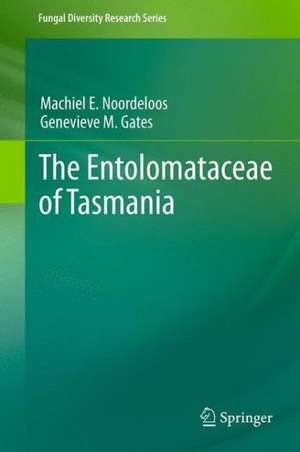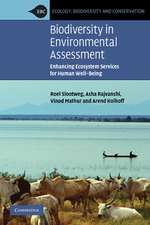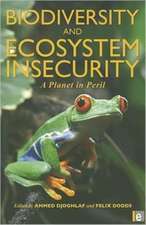The Entolomataceae of Tasmania: Fungal Diversity Research Series, cartea 22
Autor machiel noordeloos, Genevieve M. Gatesen Limba Engleză Paperback – 21 sep 2014
The international character of the project is further evidenced by the earlier contributions of American mycologist Tim Baroni to the Tasmanian Rhodocybe species which form the basis of the chapter on the now-expanded concept of Clitopilus, and a visit of several months in 2010 by Brazilian Ph.D. candidate Fernanda Karstedt, who tested the keys to the Entoloma species. Consequently, several thousand well-annotated collections were found during this inventory and form the basis of this monographic treatment of the Entoloma and Clitopilus of Tasmania.
The resulting 90 Entoloma species and 10 Clitopilus species are well documented with standardized descriptions, line drawings of fruit bodies and diagnostic microscopic characters, and, when available, with colour photographs. Thanks to the intensive search, it was possible to illustrate most species in colour. Dichotomous keys facilitate identification of the species. The species concept used is morphologically based; in several cases, however, identification to species level is supported by molecular data.
| Toate formatele și edițiile | Preț | Express |
|---|---|---|
| Paperback (1) | 950.03 lei 6-8 săpt. | |
| SPRINGER NETHERLANDS – 21 sep 2014 | 950.03 lei 6-8 săpt. | |
| Hardback (1) | 962.66 lei 6-8 săpt. | |
| SPRINGER NETHERLANDS – 27 aug 2012 | 962.66 lei 6-8 săpt. |
Preț: 950.03 lei
Preț vechi: 1158.57 lei
-18% Nou
Puncte Express: 1425
Preț estimativ în valută:
181.83€ • 189.12$ • 152.38£
181.83€ • 189.12$ • 152.38£
Carte tipărită la comandă
Livrare economică 13-27 martie
Preluare comenzi: 021 569.72.76
Specificații
ISBN-13: 9789400799042
ISBN-10: 9400799047
Pagini: 412
Ilustrații: XII, 400 p.
Dimensiuni: 155 x 235 x 22 mm
Greutate: 0.58 kg
Ediția:2012
Editura: SPRINGER NETHERLANDS
Colecția Springer
Seria Fungal Diversity Research Series
Locul publicării:Dordrecht, Netherlands
ISBN-10: 9400799047
Pagini: 412
Ilustrații: XII, 400 p.
Dimensiuni: 155 x 235 x 22 mm
Greutate: 0.58 kg
Ediția:2012
Editura: SPRINGER NETHERLANDS
Colecția Springer
Seria Fungal Diversity Research Series
Locul publicării:Dordrecht, Netherlands
Public țintă
ResearchCuprins
Abstract.- Author Biographies.- Part I. Introduction. 1. Introduction. General introduction. Taxonomy, phylogeny and biogeography of the Entolomataceae. Material and methods. How to study Entolomataceae. The characters used for the delimitation of taxa in Entoloma. Ecology, distribution, and phenology of the Tasmanian species.- Part II. Taxonomic part. 2. Family Entolomataceae. Synopsis of the Tasmanian species. Key to the genera.- 3. The genus Entoloma. Key to the species. Species descriptions.- 4. The genus Clitopilus. Key to the species. Species descriptions.- Index.
Recenzii
“The maps are very well done. The quality of the letters and the graphics are outstanding. … A great photographic work is also found in the pages of this book. … The microscopic and macroscopic details are beautifully and technically described. A masterful job. … It is one of the best and most complete mycology books that have been written and if you have the opportunity to read it, take advantage of it. You will enjoy it.” (revistacolombianademicologia.blogspot.com, January 31, 2022)
From the reviews:
“This monographic work comprises of two main parts. Part I is the introduction and part II is the taxonomic part. … A subject index and references allow reader easy access to the information. … should be available in all schools, community and university libraries, and any research laboratory dealing with mycology, especially higher fungi.” (Samantha C. Karunarathna and Kevin D. Hyde, Fungal Diversity, Vol. 59, March, 2013)
From the reviews:
“This monographic work comprises of two main parts. Part I is the introduction and part II is the taxonomic part. … A subject index and references allow reader easy access to the information. … should be available in all schools, community and university libraries, and any research laboratory dealing with mycology, especially higher fungi.” (Samantha C. Karunarathna and Kevin D. Hyde, Fungal Diversity, Vol. 59, March, 2013)
Notă biografică
Dr. Machiel E. Noordeloos was born in The Hague, The Netherlands in 1949. He grew up in the outskirts of an expanding post-war town, with lots of opportunities to explore the plant life of the polders and near-by coastal dunes. Already as a small child he got interested in nature, particularly botany, and started collecting and making a herbarium. In 1967 he started his biology education at Leiden University and was trained as a mycologist by Dr. C. Bas working on a revision of Marasmius in the Netherlands. In 1981 he got his PhD on a dissertation on the taxonomy and geographic distribution of Entoloma sensu lato in Europe. From 1987-1991 he was head of the Mycology Department of the Plant Protection Service in Wageningen where he studied plant pathogenic fungi and their ecology. From 1991 until his retirement in 2011 he was staff member and group leader of the Department for Plants and Cryptogams of the Netherlands and Europe at the National Herbarium of the Netherlandsin Leiden. He is editor in chief of the series Flora Agaricina Neerlandica, and published many papers and books on various groups of Agaricales, including Entolomatacae, Marasmiaceae, and Strophariaceae, with a focus on Europe and Australia. In 2009 he was awarded the Clusius Medal of the Hungarian Mycological Society. He is honorary member of the Dutch Mycological Society.
Dr. Genevieve Gates (née Piscioneri) was born in Pyramid Hill, Victoria, Australia in 1952. Her father, an irrigation engineer, moved the family from the hot, dry, dusty Mallee of Victoria to the cooler climes of the island of Tasmania in 1959 where she continued her education, culminating in a BSc degree majoring in Botany and Zoology at the University of Tasmania in 1974. She worked for several years as a laboratory technician at the Department of Agriculture at the University before becoming a full time mother. In 1998, in the middle of raising her three sons, she was drawn back to her botanicalstudies and became very interested in the taxonomy of Tasmanian fungi, in particular the family Entolomataceae. In 2009, she was awarded a PhD in Mycology and Forest Ecology for her study which investigated the macrofungal assemblages associated with wood, soil and litter in the wet eucalypt forests of southern Tasmania. Currently, she is an Honorary Research Associate in the Schools of Plant Science and Agricultural Science at the University of Tasmania, supervising students and doing molecular research on Gondwanan wood-inhabiting fungi in collaboration with Dr. Mario Rajchenberg of Esquel, Argentina.
Textul de pe ultima copertă
This book is the result of 14 years of collecting Entolomataceae in the native forests of Tasmania, Australia. Although initially involving only the Tasmanian residents Genevieve Gates and David Ratkowsky, who made twice- or thrice-weekly forays into the forests throughout the year, the project was subsequently joined by agaric specialist Machiel Noordeloos from the Netherlands, and by fungi photographer Michael Pilkington from the United Kingdom.
The international character of the project is further evidenced by the earlier contributions of American mycologist Tim Baroni to the Tasmanian Rhodocybe species which form the basis of the chapter on the now-expanded concept of Clitopilus, and a visit of several months in 2010 by Brazilian Ph.D. candidate Fernanda Karstedt, who tested the keys to the Entoloma species. Consequently, several thousand well-annotated collections were found during this inventory and form the basis of this monographic treatment of the Entoloma and Clitopilus of Tasmania.
The resulting 90 Entoloma species and 10 Clitopilus species are well documented with standardized descriptions, line drawings of fruit bodies and diagnostic microscopic characters, and, when available, with colour photographs. Thanks to the intensive search, it was possible to illustrate most species in colour. Dichotomous keys facilitate identification of the species. The species concept used is morphologically based; in several cases, however, identification to species level is supported by molecular data.
The international character of the project is further evidenced by the earlier contributions of American mycologist Tim Baroni to the Tasmanian Rhodocybe species which form the basis of the chapter on the now-expanded concept of Clitopilus, and a visit of several months in 2010 by Brazilian Ph.D. candidate Fernanda Karstedt, who tested the keys to the Entoloma species. Consequently, several thousand well-annotated collections were found during this inventory and form the basis of this monographic treatment of the Entoloma and Clitopilus of Tasmania.
The resulting 90 Entoloma species and 10 Clitopilus species are well documented with standardized descriptions, line drawings of fruit bodies and diagnostic microscopic characters, and, when available, with colour photographs. Thanks to the intensive search, it was possible to illustrate most species in colour. Dichotomous keys facilitate identification of the species. The species concept used is morphologically based; in several cases, however, identification to species level is supported by molecular data.
Caracteristici
Modern treatment of Entolomataceae Keys to genera and species Full descriptions and colour plates and line drawings












